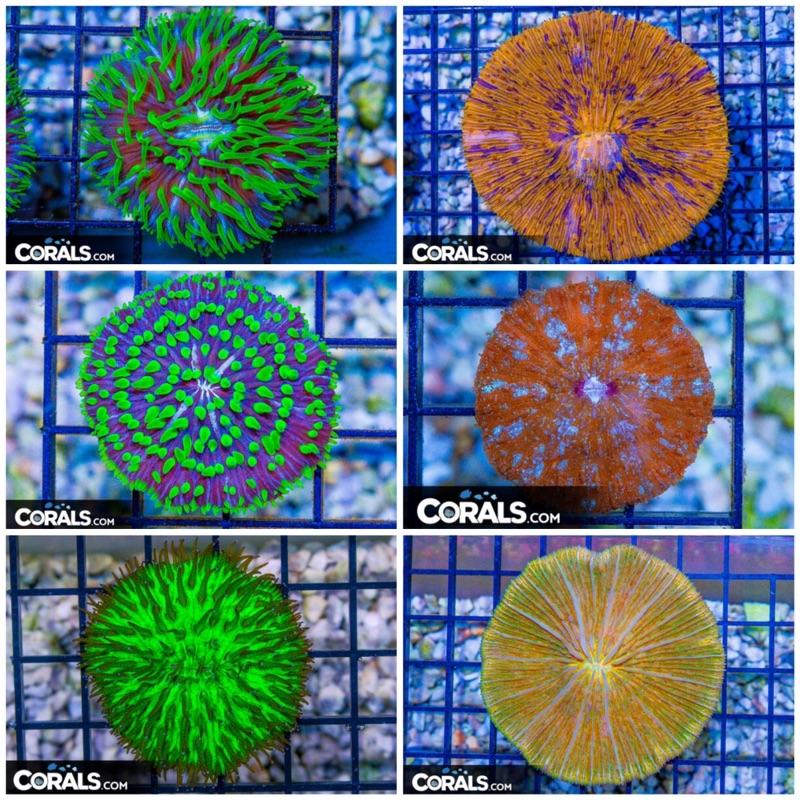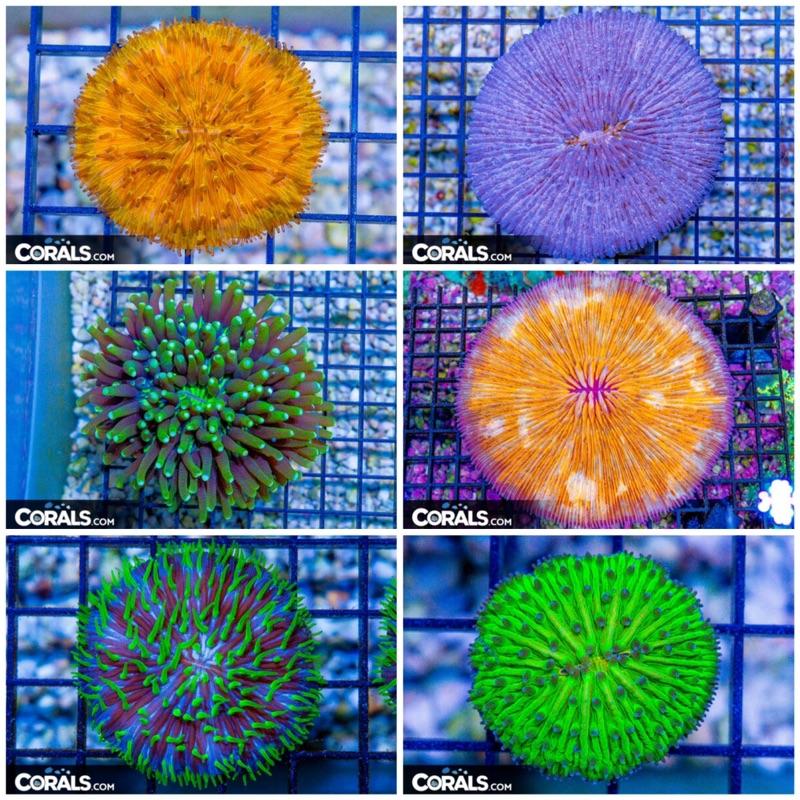- Location
- Warren, OH
Hey Reefers! Let's talk Plate Corals!
Plate corals are easily one of the most unique and recognizable corals in our industry! These LPS (Large Polyp Stony) corals are usually round and almost completely flat, like a plate! Their skeletons are surrounded in a layer of brightly colored flesh, with a single mouth in the center of their bodies, and sometimes covered in a rows of short, colored tentacles. However, this is not always the case, some species have multiple mouths and more of a dome structure! As well as longer tentacles! Nevertheless, plate corals are an incredible part of our hobby, let's dive into them a little deeper down below!
There are several different species of Plate Corals that come from a variety of countries. Fungia, Heliofungia, Diaseris, and Lithophyllon to name a few! Aussie and Indo are the primary sources, but there are also ones that come from Fiji and Tonga! We have carried almost all the different types plate corals, in all different color combinations and patterns, with new ones showing up all the time!
Plate corals come in a wide variety of looks! Usually being very vibrant and colorful! Bright shades of Neon Green, Orange, Purple, Yellow, Red, Pink, and many more, make up their flesh and tentacles! Different color combinations, and patterns, making for stunning pieces! Their coloration isn't even the most unique part about plate corals! They are one of the only corals that have the ability to move, some of them are completely mobile! They inflate and deflate their flesh, scooting across the sand bed with the help of the current! While it is usually quite a slow process, they absolutely can do it! Check out a short timelapse video of one slightly moving, HERE!
Plate Corals are generally considered easy to care for. They require moderate flow and lighting, and usually are not too picky about where they are placed (as they'll find a spot they like!) However, just make sure they're placed on the bottom of your tank. Plate corals should be placed down on your substrate, so their flat bodies are able to be supported. We recommend a larger substrate like crushed coral, as smaller and finer substrate could get blown on top of them, damaging their flesh!
When it comes to feeding and energy production, Plate corals, like most corals, are photosynthetic, due to the symbiotic zooxanthella in their flesh! They also benefit from occasional spot feeding. We feed a mixture of finer foods, usually smaller mysis and brine shrimp! Spot feed the food around their mouth and tentacles, and they'll slowly work it to the center to eat! Plate corals can be easy, and fun to keep, if you'd like to read up a bit more about them, check out some awesome articles about them on Reefbuilders, HERE!
We have a great selection of Plate Corals that are sure to stand out on the bottom of your tank! Check out several of our favorites currently in stock down below, but click any photo to shop them all instantly! Don't forget about our huge Christmas in July Sale ending tomorrow night! Scoop one up at a great discount before it's too late!
Thanks so much for checking out our Saturday Spotlight, and have a great weekend! ~ Corals.com


Plate corals are easily one of the most unique and recognizable corals in our industry! These LPS (Large Polyp Stony) corals are usually round and almost completely flat, like a plate! Their skeletons are surrounded in a layer of brightly colored flesh, with a single mouth in the center of their bodies, and sometimes covered in a rows of short, colored tentacles. However, this is not always the case, some species have multiple mouths and more of a dome structure! As well as longer tentacles! Nevertheless, plate corals are an incredible part of our hobby, let's dive into them a little deeper down below!
There are several different species of Plate Corals that come from a variety of countries. Fungia, Heliofungia, Diaseris, and Lithophyllon to name a few! Aussie and Indo are the primary sources, but there are also ones that come from Fiji and Tonga! We have carried almost all the different types plate corals, in all different color combinations and patterns, with new ones showing up all the time!
Plate corals come in a wide variety of looks! Usually being very vibrant and colorful! Bright shades of Neon Green, Orange, Purple, Yellow, Red, Pink, and many more, make up their flesh and tentacles! Different color combinations, and patterns, making for stunning pieces! Their coloration isn't even the most unique part about plate corals! They are one of the only corals that have the ability to move, some of them are completely mobile! They inflate and deflate their flesh, scooting across the sand bed with the help of the current! While it is usually quite a slow process, they absolutely can do it! Check out a short timelapse video of one slightly moving, HERE!
Plate Corals are generally considered easy to care for. They require moderate flow and lighting, and usually are not too picky about where they are placed (as they'll find a spot they like!) However, just make sure they're placed on the bottom of your tank. Plate corals should be placed down on your substrate, so their flat bodies are able to be supported. We recommend a larger substrate like crushed coral, as smaller and finer substrate could get blown on top of them, damaging their flesh!
When it comes to feeding and energy production, Plate corals, like most corals, are photosynthetic, due to the symbiotic zooxanthella in their flesh! They also benefit from occasional spot feeding. We feed a mixture of finer foods, usually smaller mysis and brine shrimp! Spot feed the food around their mouth and tentacles, and they'll slowly work it to the center to eat! Plate corals can be easy, and fun to keep, if you'd like to read up a bit more about them, check out some awesome articles about them on Reefbuilders, HERE!
We have a great selection of Plate Corals that are sure to stand out on the bottom of your tank! Check out several of our favorites currently in stock down below, but click any photo to shop them all instantly! Don't forget about our huge Christmas in July Sale ending tomorrow night! Scoop one up at a great discount before it's too late!
Thanks so much for checking out our Saturday Spotlight, and have a great weekend! ~ Corals.com





